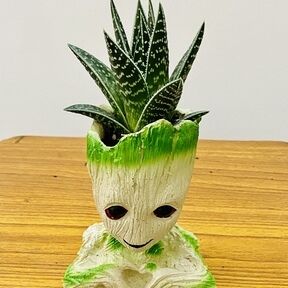
Store
Plants Care Guide
General Care Tips:
- Water Thoroughly. Wet the entire root ball, and let excess water run out the bottom of the pot.
- Don't leave standing water in the catch-tray. Doing so can promote root diseases.
- Allow the soil to partially dry before watering again. To check soil moisture, stick your finger into the top 2 inches of soil. If it is dry, it's probably time to water.
- Fertilize your plants with Vermicompost once a month.
- Spray Neem oil twice a month to keep the pests away.
For Succulents:
- Spray water on the soil once a week. Never overwater your succulent.
- Use the special succulent soil mix to have good aeration.
- Keep them in bright light or else in sunlight at least once a week for 6-8 hours.
- They like warm places with good air ventilation.
- Do not put your succulent in the Washroom
Follow @go.planto on Instagram and let your plants live forever with our care tips.
| Common Problems | Reasons | Solution |
| YELLOWING LEAVES | Older plant leaves may yellow and drop off as part of the natural aging process and this is completely normal. However, if lots of leaves are turning yellow, including new growth, it's possible your plant is getting too much light. | Try moving it to a spot with indirect light and see if it improves. |
| LEAVES DROPPING | Temperature: Often, excessive heat or cold drafts are to blame for a houseplant dropping leaves. Be careful of placing plants on windowsills, which may be too hot in the summer and too cold in the winter. Another possible reason could be water logging. | Keep plants away from fireplaces, air conditioners and heat vents. Keep plants away from draft doors and windows. |
| LEAVES CURLING | This can occur when a plant is subjected to long periods of drought or low humidity. | Try and water as regularly as possible and provide extra moisture by misting the leaves. |
| BROWN LEAF-EDGES | Dry air or underwatering are the major causes here. Another culprit is over-fertilizing, where leaf burn can present as browning tips. | Always follow packet instructions and err on the side of caution when using fertilizer. It's much better to over-dilute than the other way around! |
| WILTING OR BURNT LEAVES | This is a pretty clear sign that your plant is getting too hot, and potentially burned by the harsh sun. | Tropical foliage, in particular, is easily burnt by the direct sun and needs to be positioned away from windows where the glass magnifies the sunlight. The afternoon sun is particularly strong and damaging to many indoor plants. |
| ROOT ROT | Root Rot can be caused by waterlogged soil or various kinds of fungi. Soil can become waterlogged for a number of reasons, including poor drainage, continuous heavy rainfall, and overwatering. Root rot can be a nasty disease when left untreated. If you’ve noticed your plant’s roots are soft and black in color, that usually means your houseplant is suffering from root rot. | Adequate drainage and a regular watering schedule are the best ways to avoid root rot. |
| LEGGY OR SPARSE GROWTH | This is a pretty clear indicator that your plant is not getting enough natural light. | Reposition it in a spot with brighter light or a longer period of light exposure. |
| APHIDS | These tiny insects are extremely common and are usually found on the undersides of leaves or at the tip of the plant. If they’ve made your plant their long-term home, you may begin to see feeding damage. This usually includes stunted plant growth, smaller leaves, and distorted foliage. | Something as simple as a splash of water can remove the insects, but if you want a more immediate solution, you can opt for an indoor insecticide spray from your local gardening store. |
| FUNGUS GNATS | If your plant is experiencing root issues, you may have a fungus gnat problem. These little guys like to feed on plant roots and decaying organic material in the soil, which can affect the growth and overall well-being of your plant. | There are several options available when it comes to gnat removal. Spraying the plant with soap and water is a simple household fix, or you can opt to get yellow sticky traps from the store. Or, if you have spare potatoes lying around, cut them up and place the pieces in the soil — the gnats will be drawn to them! |
| SPIDER MITES | Spider mites like to hang on the underside of leaves and damage usually occurs from the webbing produced on foliage and stems. | Letting dish soap sit on the plant for a couple of hours can help remove spider mites, but you can also choose a harsher solution like rubbing alcohol. Soak a few cotton balls in rubbing alcohol and wipe them on the foliage. After a few hours, rinse the layer with water. |
| WHITEFLIES | These gnat-like insects are soft-bodied and usually found in a light yellow or white color. These pests like to feed on the sap in plants or on the leaves, which causes them to turn yellow and sometimes even white. | Choosing a less toxic treatment for whiteflies will do the job just fine. Some options include neem oil, insecticidal soap or petroleum-based oils. Spray one of these solutions onto the affected areas and repeat as necessary. |
| THRIPS | These insects are almost impossible to see with the naked eye. They tend to be light tan to dark brown in color and like to feed on foliage and flowers. They pierce the plant with their mandible and suck up the juices that seep from the wound. This can cause the plant to become distorted and discolored over time. | If you can, prune and cut down any affected areas of the plant. A less invasive option includes mild treatments like insecticidal soap and neem oil, which you can spray on the parts of the plant that have a thrip infestation. |
| POWDERY MILDEW | This particular disease can be easily identified on your affected plant — if you clearly see white powdery fungal growth on foliage, that is a sure sign that its powdery mildew. Though not typically fatal, this disease can spread and affect plant growth drastically, even causing leaf distortion in some cases. | Remove affected foliage from the plant to prevent it from spreading. Combine 1 tablespoon of baking soda with ½ teaspoon of non-detergent soap and place the solution in a gallon of water. Pour the mixture into a spray bottle and coat all the affected areas of your plant. This solution can help control the mildew from spreading, though keep in mind that it can be harmful to your plants, so be sure to generously water your plant a few days after treating it. |
| GRAY MOLD | This type of fungus is a common disease that’s usually found in flowers and can spread quickly, causing severe harm to your plant. It can be easily identified if you notice brown spots on the plant that eventually turn into a thick gray mold. Do not ignore these signs as gray mold can kill the plant! | Decrease humidity around the plant and increase air circulation. Like most types of fungi, gray mold thrives in moist and humid environments, so it’s important to keep the plant in a dry space. In severe cases, you can opt to use a fungicide to treat the plant. |
| LEAF SPOTS | As the name suggests, this disease can be identified as tiny spots on your plant’s leaves that usually show up in shades of black, brown, yellow or tan. When these spots combine, it can result in leaf drop and distortion. | Remove the infected leaves and increase air circulation in your house. Try not to get water on the leaves and avoid reusing infected potting mixes. Also, be sure to water early in the day so it has time to dry before nightfall! |
| STRETCHING | Plants that aren’t receiving enough sunlight can be identified with light green foliage — they also begin to lean towards the light source, which is called stretching. | If you have a plant that requires 6-8 hours of sunlight, you’ll want to move it by a south-facing window, which tends to be the brightest. Be sure to rotate your plants so all sides get an equal amount of sunlight. |
About Us

Groot
Plantsman
There are thousands of nurseries around to pick up a plant, we at GoPlanto strive hard to make our customers understand the adequate care to have their plants love them more! We love nature and want to spread joy for those who feel the same. We not only sell plants but also beautify spaces with exquisite scenery and empower nursery farmers across India. We strongly believe in living healthy and doing our bit for a greener tomorrow.
"The glory of gardening: hands in the dirt, head in the sun, heart with nature. To nurture a garden is to feed not just on the body, but the soul."

Great service, reasonable prices and received some wonderful tips on managing indoor plants!

Had a long conversation with them and they cleared all my plant care doubts very patiently. I honestly can't recommend them enough.
